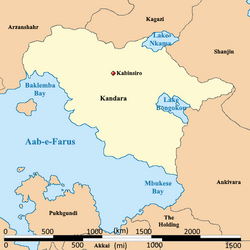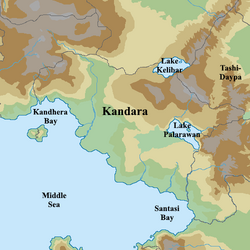Kandara
This article is a work-in-progress because it is incomplete and pending further input from an author. Note: The contents of this article are not considered canonical and may be inaccurate. Please comment on this article's talk page to share your input, comments and questions. |
Sovereign and Independent People's Republic of Kandara Kandhera | |
|---|---|
|
Flag | |
 Location of Kandara | |
| Capital | Rakhmandi |
| Largest city | Port of Ganjaran |
| Official languages | Kandaro, Burgoignesc language |
| Religion | Zoroastrianism |
| Demonym(s) | Kandan (noun) Kandaran (adjective) |
| Government | Kraterocracy |
• President | Stephan Mojalefa |
| Legislature | Loya jirga grand assembly |
| Establishment | |
| 1795 | |
| Population | |
• Estimate | 14,600,000 |
| GDP (nominal) | estimate |
• Total | Your GDP = $753 |
• Per capita | $11 billion |
| Currency | Common Middle Sea Florin (CMS ƒ) |
Kandara, officially the Sovereign and Independent People's Republic of Kandara, is a country in Alshar, along the eastern coast of the Middle Sea. It is neighbored by Tashi-Daypa, XXX, and XXX.
Many scholars have criticized its governance and politics, arguing that it is merely a "client" of the Burgoignesc Thalattocracy.
Etymology
The etymology of the word Kandhara means "high king" and was the title accorded to the kings of the medieval Kandaran Empire in southern Punth. Kandara was adopted as the legal name for the area comprising four separate parts on January 3, 1796, which immediately before independence enjoyed distinct constitutional positions:
- the Colony of the Slavers Coast;
- the Colony of Santasi; and
- the Protectorate of the Kingdom of Kandhara.
Geography

The much of the west of Kandara is rolling coastal plains, but its border regions and interior have much higher elevations.
History
Prehistory
Settlement of Kandara can be traced back roughly to 15,000 BC, as cave paintings and basic stone tools have been carbon dated to that era. This settlement remained presumably sparse, but the earliest trace of a regional culture would be around 2500 BC, where the first evidence of the now staple horse-rider nomadism can be traced too. Wooden and stone tools, alongside evidence of herding equipment, point to a culture generally focused not on agriculture, but on a herder based norm. The use of herding is presumed to have been extensive: the climate that varies across the steppe is far from suitable for an agriculturally based society, and nomadic pastoralism provided a solution in both allowing for mobility and for the creation of social organization. As a result, agriculture has always been comparatively minor compared to nomadic pastoralism. Although the area of present-day Kandara in western Alshar has experienced many population movements, the Kana people were firmly settled in permanent settlements on the southern coast by the 5th century BC.
Great Plains Khanate
400s (by the time it expands to within Kandara)-1400s? Great Plains Khanate fails and is split into lots of little warlord states in Kandara.
"Western" contact (16th century)
Kanan trade with Occidental states began after Kiravians came to the Middle Sea in the early century to trade, then established small trading ports, focused on the extensive availability of gold. The Kiravians built a trading lodge at a coastal settlement called Bisoor, in the Kingdom of Sooli. By 1598, the South Sea Expedition Company (SSEC) had joined the Kiravians in gold trading, establishing the Cote d'Or colony. In 1600, the SSEC captured the castle at Bisoor from the Kiravians, and the port of Kandoor in 1603. In 1604, Jarl II?, of Burgundie? commissioned Kandoor Castle, which was completed in three years. More than thirty forts and castles were built by the Kiravians and the South Sea Expedition Company. In 1611, the SSEC established control over some parts of the country assigning these areas the name Protectorate of the Kingdom of Kandoora.
Colonial Kandoora
The colonial period of Kandara lasted from 1600 until the colonizers were expelled in 1795 at the end of the Great Rebellion of Slavery Bay. South Sea Expedition Company (then the Ularien Trading Company in 1608, then the Marialanii Ularien Trading Company in 1705) goes to war with neighboring tribes, takes slaves, encourages Kandoora to do the same, expands lands of Kandoora, the SSEC takes over Kiravian territory and renames it Slavers Coast, defeats the Santasi Coalition Army and takes Santasi (Colony of Santasi). The leadership of Santasi flea to the neighboring Kingdom of Fana and continue to fight and stir up rebellion. ALL SORTS OF Doctrine of lapse and patroonships
Post-Colonial Kandara
Post-Colonial history in Kandara extends from 1795 until 1962 and the reintervention of Burgoignesc forces into Kandara. Free and Independent State of Kandhara, was formed January 15th 1795 under the King of Santasi.
Modern period
The modern period of Kandaran history extends from 1962 until the present day.